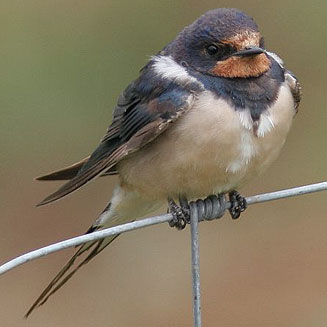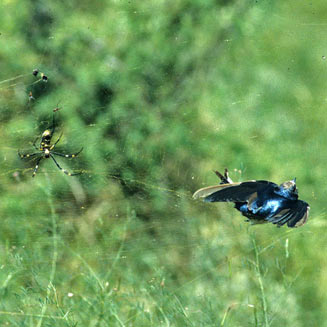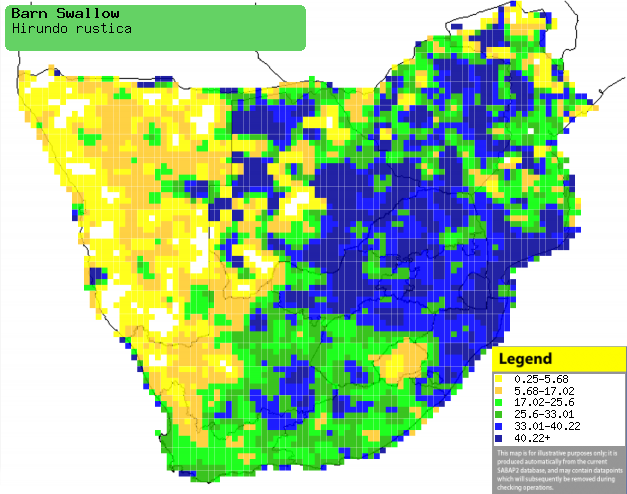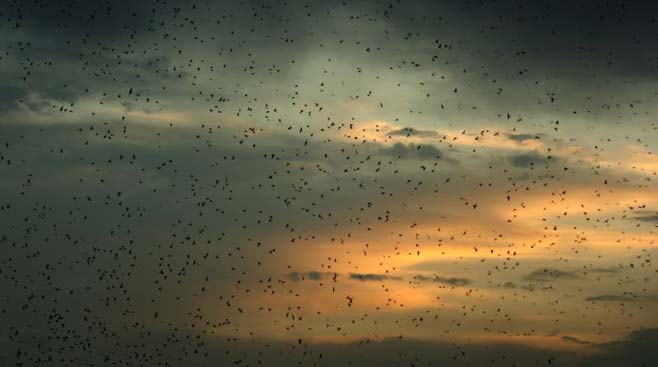|
Hirundo rustica (Barn swallow,
European swallow)
Europese swael [Afrikaans]; Inkonjane (generic term for
swallow), Ucelizapholo, Udlihashe [Xhosa]; iNkonjane (generic term for swallows)
[Zulu]; Sisampamema (generic term for swallows, martins, swifts and spinetails)
[Kwangali]; Lefokotsane (generic term for swallow), ’Malinakana (also applied
to Greater striped swallow), Lekabelane [South Sotho]; Nyenganyenga (generic
name for swallow or martin) [Shona]; Inkonjane (generic term for swallows)
[Swazi]; Nyengha (generic term for swallow) [Tsonga]; Pêolwane, Phêtla
(generic terms for swifts, martins and swallows) [Tswana]; boerenzwaluw [Dutch];
Hirondelle rustique [French]; Rauchschwalbe [German]; Andorinha-das-chaminés
[Portuguese]
Life
> Eukaryotes >
Opisthokonta
> Metazoa (animals) >
Bilateria >
Deuterostomia > Chordata >
Craniata > Vertebrata (vertebrates) > Gnathostomata (jawed
vertebrates) > Teleostomi (teleost fish) > Osteichthyes (bony fish) > Class:
Sarcopterygii (lobe-finned
fish) > Stegocephalia (terrestrial
vertebrates) > Tetrapoda
(four-legged vertebrates) > Reptiliomorpha > Amniota >
Reptilia (reptiles) >
Romeriida > Diapsida > Archosauromorpha > Archosauria >
Dinosauria
(dinosaurs) > Saurischia > Theropoda (bipedal predatory dinosaurs) >
Coelurosauria > Maniraptora > Aves
(birds) >
Order: Passeriformes > Family: Hirundinidae
 |
 |
|
Barn swallow, Ntsikeni Nature Reserve, South
Africa. [photo Trevor Hardaker ©] |
Immature barn swallow caught in a Nephila spp
Golden Orb Web Spider's web, Greater Umbabat Nature Reserve, South
Africa. [photo Johann Grobbelaar
©] |
Distribution and habitat
Abundant and widely distributed, with breeding grounds
across North America and Eurasia. In the non-breeding season the population
moves south to South America, Africa and southern Asia. In southern Africa it
can occur in any habitat, although it is uncommon in arid, semi-arid and high
altitude (e.g. Lesotho) areas. It is generally more common in the moist eastern
half of the region, favouring Miombo (Brachystegia) woodland, open
grassland, pastures, cultivated fields, open water and vleis.
|
 |
|
Distribution of Barn swallow in southern Africa,
based on statistical smoothing of the records from first SA Bird Atlas
Project (©
Animal Demography unit, University of
Cape Town; smoothing by Birgit Erni and Francesca Little). Colours range
from dark blue (most common) through to yellow (least common).
See here for the latest distribution
from the SABAP2. |
Predators and parasites
It has been recorded as prey of the following animals:
An infection of Hyalomma rufipes (Heavy tick) caused
several fatalities in Zimbabwe.
Movements and migrations
Most birds arrive in our region during October-November,
leaving in huge flocks (see image below) around March and April.
 |
|
Some of the roughly 3 million birds in a flock
roosting in a wetland near Mount Moreland, north of Durban, South
Africa. [photo Alan Manson
©] |
Foraging and food
It mainly eats insects, doing most of its foraging near the
ground, rapidly hawking prey from the air or on vegetation, occasionally from
the ground. The following food items have been recorded in its diet:
- Insects
- ants
-
Diptera (flies)
- Coleoptera
(beetles)
-
Hemiptera (bugs)
-
Lepidoptera
- Bollworms (larvae of Noctuidae) taken from cotton heads.
- Spodoptera exempta (Armyworm)
- Talorchestia capensis (Beach hoppers)
-
Spiders
- Fleshy arils of Acacia cyclops (Rooikrans)
Threats
Not threatened, in fact an estimated that 22-44 million
birds from western Europe and 44-88 million from eastern Europe and Asia enter
Africa annually, and this doesn't include the American population.
References
-
Hockey PAR, Dean WRJ and Ryan PG 2005. Roberts
- Birds of southern Africa, VIIth ed. The Trustees of the John Voelcker
Bird Book Fund, Cape Town
-
Harrison, J.A., Allan, D.G., Underhill, L.G., Herremans, M.,
Tree. A.J., Parker, V. & Brown, C.J. (eds). 1997. The atlas of southern
African birds. Vol. 2: Passerines. BirdLife South Africa, Johannesburg.
|
